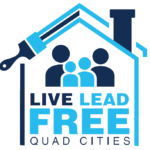Lead Is a Poison.
Lead is a naturally occurring metal that can cause negative health effects to both children and adults. People are exposed to lead by eating lead paint chips or items contaminated by lead, and by breathing in lead dust.
There is no safe level of lead in the body, especially in children ages 1 year to 6 years of age.
Young children are growing and developing rapidly and are more likely to put their hands in their mouths increasing their potential to become lead poisoned and to suffer from long-term health effects. Research shows that any amount of lead found in a child’s body may affect their growth and development, their ability to pay attention, and may cause permanent damage to their brains. Often, the effects of lead poisoning are difficult to see with most children having no immediate, obvious symptoms.

Lead poisoning causes permanent health problems.
Lead poisoning causes harm even at very low levels. Children poisoned by lead can have problems with attention length, hyperactivity, growth, reading and learning problems, hearing loss, sleeping, and a range of other health, school, and social problems. A child with low levels of lead poisoning may not have any symptoms, and a blood test is the only way to know if a child is poisoned. Lead poisoning can cause permanent brain damage, coma, seizures, and even death at very high levels.
Lead poisoning is 100% preventable.
You can protect your family by knowing where lead can be found in your environment and what the dangers are when lead is moved. Even if your home may be free of lead-based paint dangers, your child could still come in contact elsewhere, especially if they spend time in a building built before 1978. This includes schools, daycare centers, in-home daycare, and homes of relatives.

Nutrition can help fight lead poisoning!
Make sure your child never has an empty stomach by giving them healthy snacks throughout the day. Read nutrition labels while grocery shopping to check how much iron, calcium, and vitamin C are in each item you buy. If you are in the Women, Infants, and Children (WIC) program, many of the foods you already buy are high in these nutrients!

